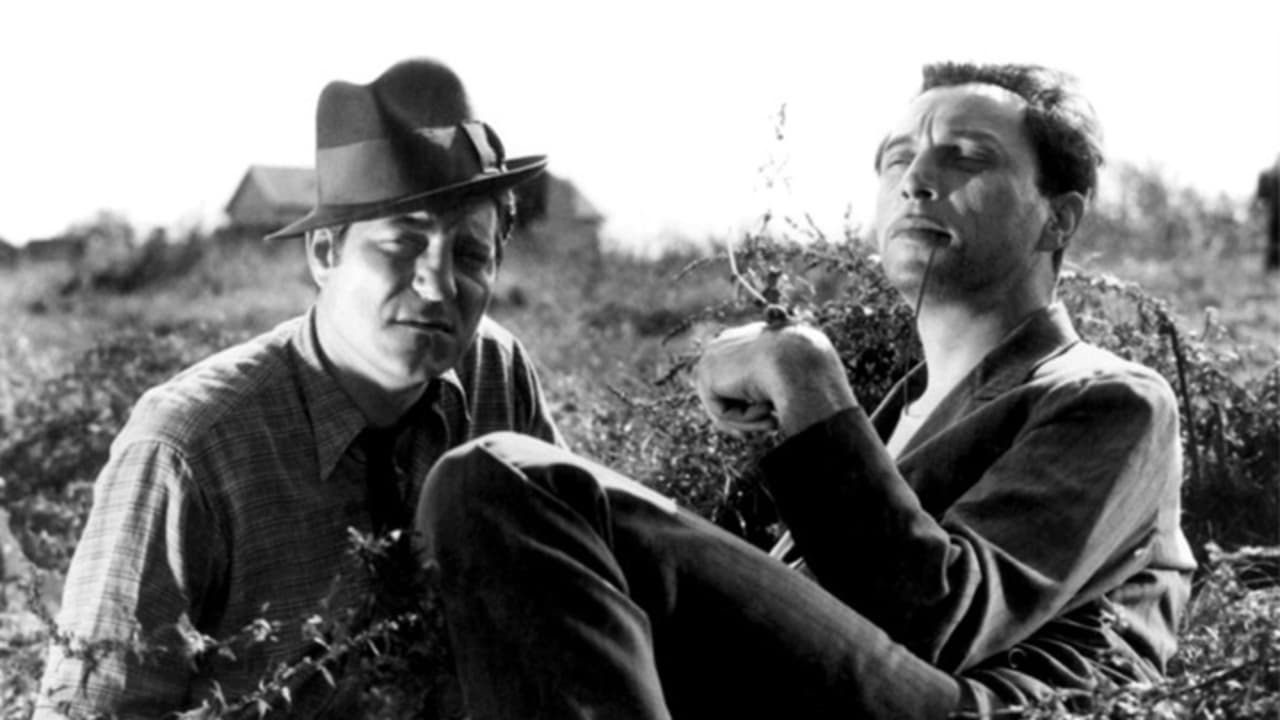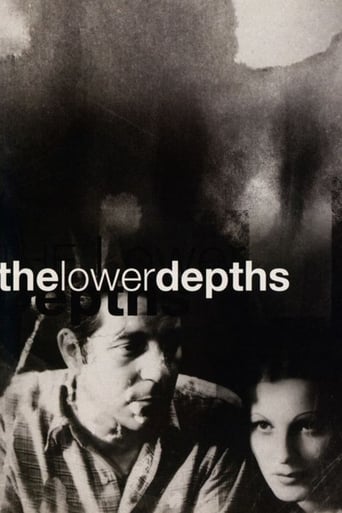



Brilliant and touching
Tells a fascinating and unsettling true story, and does so well, without pretending to have all the answers.
View MoreIt is both painfully honest and laugh-out-loud funny at the same time.
View MoreYes, absolutely, there is fun to be had, as well as many, many things to go boom, all amid an atmospheric urban jungle.
View MoreAdapted from Maxim Gorki's novel of the same name, "The Lower Depths" is a strange but oddly captivating immersion in French post-Depression misery and pre-War life contemplation. Or maybe I should correct this statement, the film is supposed to be set in Russia, the characters kept their original Slavic names and the currency used is definitely not Francs, so I stand corrected, Jean Renoir intended to be faithful to the crux to the novel but did he really expect the audience to be fooled? Behind the Russian facade, it is a no less relevant depiction of French mentalities, which is perhaps the best credit to Gorki's universal appeal.Universal, international, those were words with strong resonance in the France of 1937, one year before, it was marked by election of 'Popular Front' government, the historical triumph of the left-wing united parties whose first symbolical initiative was to implement the two-year paid vacation. The image of people traveling across France in bikes and to the seaside, some for the first time, was one of the most emblematic images of the pre-war period, a sort of fresh breath of air before politics would change the map of the world. It was a time where many artists embraced that sense of freedom and inter-classes fraternity that characterized France and maybe it's not such a hazard if the film features the unlikely friendship between a wealthy baron and a burglar, both played with immense talent by legends Louis Jouvet and Jean Gabin.It might have helped a little that the baron went bankrupt because of gambling and the thief was looking for the one robbery to make him rich and honest once and for all, these are people who try to look beyond their conditions and could see their path crossing. It is also quite interesting that Renoir, who would later make two masterpieces about the fall of the grand bourgeoisie and aristocratic order in "Grand Illusion" and "Rules of the Game" always told it from the perspective of the bourgeois people, as he was said to be, contrarily to Marcel Carné, more at home with the upper class setting than the blue-collar, his world doesn't feature crowded streets or vendors, it's not the same 'atmosphere' than "Hotel du Nord" (the connoisseurs will get the reference), it is like Renoir adopted a naive approach to misery, in a sort of 'Grand Hotel' setting, where poor people discuss about marriage, freedom, liberty and have no interactions with the baron.To a certain extent, there seems to be an order in that class where order doesn't prevail, while the aristocratic world is collapsing through social conventions and gambling, like the real theater for rebellion. Renoir is no Dickens but that doesn't affect at all the quality of the film and some superb imagery. There is a shot I especially loved where Jouvet is staring at the camera incapable of burning a cigarette, it is one of the most eloquent shots of anger, and you could tell it is directly addressed toward himself. And it is strange how in the other world, there is an obvious antagonist, an old and mean landlord whose wife flirts with Gabin as Pepel (who happens to be in love with her sister, played by Suzy Prim). The slums are filled of a love triangle, a villain, a jealous mistress, all the social archetypes of the upper class while the real rebel and free-spirited 'hero' or antihero is the bankrupt baron Jouvet, no wonder he immediately befriends Gabin, who's not exactly like a fish in water in the slums and strikes as much a misfit as the baron.I couldn't translate these words in English without losing the rhetorical kinship but the friendship is between a 'déclassé' (socially downgraded) and an "inclassable" (indefinable) person, one who lost his place and is pretty content about it and one who seeks it. Pepel is in the romantic hero tradition, he believes only love can get him off prison, some lost hope and act like drunkards and other try to bribe the corrupt power incarnated by the fat policeman, this is overall one pathetic portrait of society reconciled through the sight of the two protagonists, the buddies. I must say I was more interested by the friendship than the romance as it had to be a driver to Gabin's escape, one that would justify the last shot that is a total homage to Chaplin's "Modern Times", and that's a tribute to Chaplin's impact on the world, one year after his masterpiece, he was already imitated.And yes, maybe there's something Chaplinesque in "The Lower Depths", more than Gorki, which made me wonder if the film wouldn't have worked better with French names and French setting.The film received the Deluc prize and met with critical acclaim but it's not the most famous work from Renoir who'd make more consistent statements through his following masterpieces. But on its own, it's a good example of French poetic realism and one of Gabin's best pre-war roles.
View MoreI was not aware of the Gorki's job and I was interesting of one of Jean Renoir's work as he is one of the best French director of all time. My global feeling was good but mixed with some aspects.First the reflexion about low class condition is good on many ways but was losing his force at the end. I think the optimistic way that it ended (Pepel going with Natasha) was an attempt to give a romantic aspect and was deviated from his social purpose. I expected a more dramatic final more realistic.Let's talk about the Baron who seems to be a central character at the beginning. In the second half, he becomes a secondary one. The first part of the movie let suggest an ambiguous relation with the main character Pepel. Nothing like this in the second part. I am wondering why there is so much emphasize in their relation at the beginning (Many fascination between each other). The rhythm is sometime unequal especially around 2/3 of the movie. There are some satisfactions: Jean Gabin has got a natural presence in front of the camera and we always enjoy seeing him. Despite of some defaults, reflexions and painting of the lower dephts are very real and authentic.Jean Renoir was following his instincts and his interests for socialism more than looking for something entertaining. There are bad aspects but I have enjoyed watching this one. Let see Kurosawa with his adaptation. Marduk
View MoreIt was not the first time Renoir had tackled a literary work:he had already transferred to the screen Zola's "Nana" and Flaubert's "Madame Bovary" .More masterpieces were to follow with Maupassant's "Une Partie de Campagne" -though unfinished,it's my favorite- and Zola's(again)"La Bete Humaine".I do not think that "les Bas-Fonds" is in the same league as the four works I mention above.The problem lies in the fact that this is a Russian classic and that a French director cannot "feel" it like he does in a celebrated novel of his cultural heritage such as "Madame Bovary".Yes,the names are kept,and they pay in Roubles and Kopecks.It's not enough to create a Russian atmosphere .Renoir told that he wanted to Frenchify the novel :but Gabin and Jouvet ,although they are the creme de la creme of French actors of that era (and of all time) ,are not credible as Russians or Frenchified Russians.Renoir's permanent features of the thirties are present.His anarchist mind ,present in such works as "La Chienne " and "Boudu Sauvé des Eaux" comes to the fore:the endings of "Boudu" and "Les Bas-Fonds" are similar ,when the two heroes hit the road,turning their back on a society they despise.Suzy Prim's Vassilissa is a distant relative of Lulu "La Chienne".
View MoreThe Criterion Collection offers two different film versions of "The Lower Depths": one made in 1936 by Jean Renoir and another one made in 1957 by Kurosawa. The two directors never worked together on either film. In fact, they only met once in their lives, many years later. Both films are based on Russian writer Maxim Gorky's 1902 play, which describes life in a miserable slum where most characters have lost all sense of hope. Renoir deals with this serious subject matter in a much more humorous and amusing way than Kurosawa, whose film is slower, decidedly somber and a lot more difficult to digest. While Renoir's work takes the viewer in an out of the slums, Kurosawa doesn't allow one to see beyond the wretchedness of the underworld. Both films are great, but it was probably Kurosawa's which left a more durable and deeper impression on me.
View More